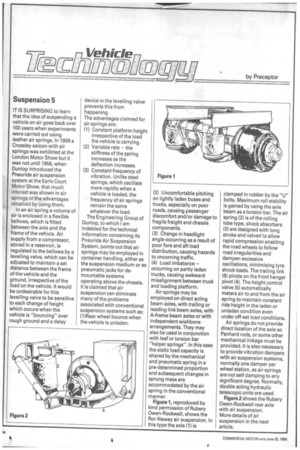Azfi c2)(r Arra
Page 46

If you've noticed an error in this article please click here to report it so we can fix it.
Suspension 5
IT IS SURPRISING to learn that the idea of suspending a vehicle on air goes back over 100 years when experiments were carried out using leather air springs. In 1909 a Crossley saloon with air springs was exhibited at the London Motor Show but it was not until 1958, when Dunlop introduced the Pneuride air suspension system at the Earls Court Motor Show, that much interest was shown in air springs or the advantages obtained by using them.
In an air spring a volume of air is enclosed in a flexible bellows, which is fitted between the axle and the frame of the vehicle. Air supply from a compressor, stored in a reservoir, is regulated to the bellows by a levelling valve, which can be adjusted to maintain a set distance between the frame of the vehicle and the ground, irrespective of the load on the vehicle. It would be undesirable for this levelling valve to be sensitive to each change of height which occurs when the vehicle is "bouncing" over rough ground and a delay device in the levelling valve prevents this from happening.
The advantages claimed for air springs are: (1) Constant platform height irrespective of the load the vehicle is carrying.
(2) Variable rate — the stiffness of the spring increases as the deflection increases.
(3) Constant frequency of vibration. Unlike steel springs, which oscillate more rapidly when a vehicle is loaded, the frequency of air springs remain the same whatever the load.
The Engineering Group of Dunlop, to which I am indebted for the technical information concerning its Pneu ride Air Suspension System, points out that air springs may be employed in container handling, either as the suspension medium or as pneumatic jacks for demountable systems operating above the chassis. It is claimed that air suspension can eliminate many of the problems associated with conventional suspension systems such as: (1)Rear wheel bounce when the vehicle is unladen. (2) Uncomfortable pitching on lightly laden buses and trucks, especially on poor roads, causing passenger discomfort and/or damage to fragile freight and chassis components.
(3) Change in headlight angle occurring as a result of poor fore and aft load distribution, causing hazards to oncoming traffic.
(4) Load imbalance — occurring on partly laden trucks, causing awkward misalignment between truck and loading platform.
Air springs may be employed on direct acting beam axles, with trailing or leading link beam axles, with A-frame beam axles or with independent wishbone arrangements. They may also be used in conjunction with leaf or torsion bar "helper springs". In this case the static load capacity is shared by the mechanical and pneumatic spring in a pre-determined proportion and subsequent changes in sprung mass are accommodated by the air spring in the conventional manner.
Figure 1, reproduced by kind permission of Rubery Owen-Rockwell, shows the Ror-Neway air suspension. In this type the axle (1) is clamped in rubber by the "U" bolts. Maximum roll stability is gained by using the axle beam as a torsion bar. The air spring (2) is of the rolling lobe type; shock absorbers (3) are designed with long stroke arid valved to allow rapid compression enabling the road wheels to follow road irregularities and dampen excessive oscillations, minimising tyre shock loads. The trailing link (6) pivots on the front hanger pivot (4). The height control valve (5) automatically meters air to and from the air spring to maintain constant ride height in the laden or unladen condition even under off-set load conditions.
Air springs do not provide direct location of the axle so Panhard rods, or some other mechanical linkage must be provided. It is also necessary to provide vibration dampers with air suspension systems, normally one damper per wheel station, as air springs are not self damping to any significant degree. Normally, double acting hydraulic telescopic units are used.
Figure 2 shows the Rubery Owen-Rockwell rear axle with air suspension.
More details of air suspension in the next article.








































































































